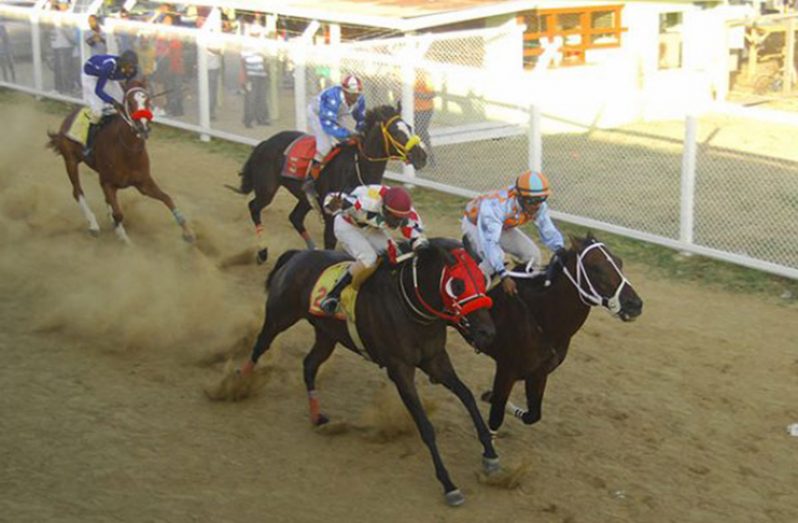-12th Annual Running of the Guyana Cup Horse Meet to kick of August 19
THE Jum-bo-Jet Thoroughbred Committee strongly believes that horse racing can help to boost Guyana’s tourism even as the body prepares to host the12th Annual Running of the Guyana Cup Horse Meet come August 19, 2018.

This Horse Meet, which is the highest level of horse racing in the country, is being predicted as the largest-ever to be hosted in Guyana with over 60 entries thus far, and 60 more expected within the next five weeks.
Up to $20 million will be up for grabs in prizes while the event is catering for up to 6,000 local and international visitors from North America, Europe and the Caribbean to the Rising Sun Turf Club in West Coast Berbice.
In an interview with the Pepperpot Magazine, Guyana’s leading horse racing commentator Compton Sancho said that there are ongoing talks with the Government for the passing of legislation which can see horses travelling back and forth to Guyana to compete.
“Horse racing puts aside a package for a lot of people in Guyana in terms of job creation, entertainment and it can boost the tourism drive. We’re working right now to get the legislation passed whereby they can bring the horse, race it in Guyana and take it back out.
That would mean a lot. It would take the tourism drive right up to the max,” Sancho said.
Even as the matter is being put forward to the Minister of Social Cohesion with responsibility for Culture, Youth and Sport and other senior Government officials, Sancho thanked those involved for their support towards the development of Horse Racing in Guyana over the years.
FOND MEMORIES
The commentator, also a committee member, has been in the business for some 45 years and first began commenting on horse racing at just 15 years old in the village of Port Mourant.
He recalled his much younger days at the age of seven when his older brother would take him to the racing tracks which is where he developed a love for the way commentators would narrate the excitement of the sport.
“He used to put me across his neck and carry me to the track and then, off my own, I used to get a piece of paper with a pen and I used to listen to the races at D’Urban Park being broadcast from Trinidad. I used to get the names of the horses, write them down and then get a nutshell, a pointer, dry stem- anything…and name them and put them in my hands and using the big canal. I would ‘jook’ five pointers in the gutter and start commenting based on the names I have on the paper and I took it from there,” he recalled humorously.
However, the journey from the very beginning to times standing has not been easy, Sancho told the newspaper saying:
“It was very much challenging in those days. You had to know how to read and write but the most exciting part is when the horses straighten up during the final [leg of the race] where you have to step up on the commentary and there is where all the excitement comes in.”
He noted some of the popular figures he remembers who have visited the horse races such as Minister of State Joseph Harmon, Minister of Education Nicolette Henry, junior Minister of Public Infrastructure Anette Ferguson, as well as a senior member of the Santa Rosa Turf Club in Trinidad.
The average racehorse weighs only 1,000 pounds or 453.5923 kg, can race at a top speed of some 40 mph and based on their performance can go up the highest which is the ‘A’ class.
Speaking on the care that needs to be provided to the thoroughbred racehorse Sancho said: “You have to train them, feed them well and get the vet to look at them.”
Meanwhile, as he described his love for the sport he said that the activity can help to unite all classes of society.
“Horse racing is full of excitement, plenty excitement. From the smallest child, as soon as they go through that Main Entry gate they just begin to feel the vibes and the excitement. I like this and I love the sport. It is a family-oriented sport and through this we assist the tourism industry in Guyana.”
For the first place prizes of the races, C-Class and lower (1600m) will contest for the $2 million; Three-year-old Guyana Bred (1100m) will compete for a $1million; G1 and Lower (1400m) will contest for $800,000; H3 and Lower (1100m) for $600,000; Two-year-old Guyana Bred (1100m) will contest for $350,000.
There will also be cash prizes for I1 and Lower (1400m) of $300,000; J3 Non-winners (1400m) for $250,000; L Class Colts and Gelding (1400m) for $200,000; L Class Fillies and Mares (1400m) of $200,000 and L and Lower Non-winners (1100m) of $150,000.
Cash prizes will also be given to the second, third, fourth and fifth place winners. The gates to the 12th Annual Running of the Guyana Cup Horse Meet will open at 10:00hrs on August 19, 2018.




.jpg)









